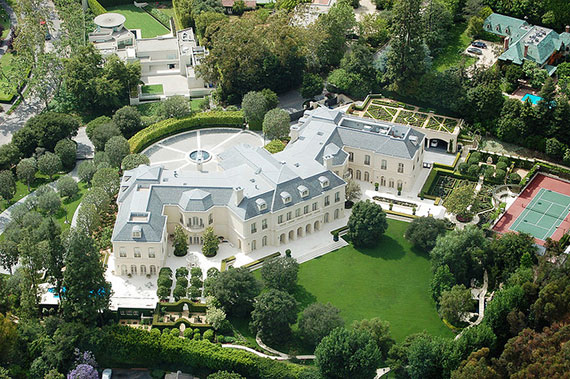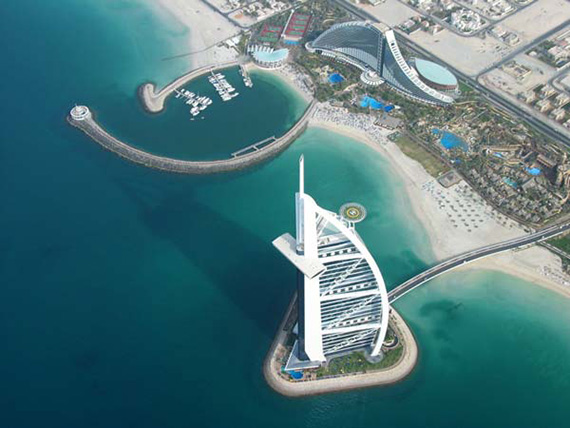Aerial photography presents unique challenges. It requires much more than just shooting from a high elevation, and it can be very mundane if not done in an artistic and creative way. Professional commercial photography is intended to sell a client’s product, whatever it may be. In the case of aerial photography, it may be that a developer needs to show a recent residential development or a new shopping center. An architectural firm may want to show a project in a scope and perspective that only an aerial photograph can properly portray; a resort may want to show its amenities and golf course. Whomever the client, an aerial photographer must create effective images that successfully illustrate and sell the product.

“Spelling Manor, Holmby Hills” by Atwater Village Newbie
A good aerial photograph should convey much more than just information about a city grid or of a landmass from a high elevation. Care must be given to the composition of your subject in aerial photography, just as it would be for any other kind of professional photograph. Most aerial photographs are taken from an oblique angle as opposed to straight down, as in satellite imagery. The oblique view gives much more interest and dimension to the image, not to mention it is much more practical to shoot from an oblique angle than from straight down.
Although one may be able to capture a satisfactory image with a few exposures, I find that for critical composition I need to circle around the view quite a few times to be certain that I have what I want for the final image. I allow 20 to 30 minutes of shooting once I get to the location. A shoot can be much faster, perhaps, but I would rather take more images to make sure that I have the perfect shot. Aerial photography requires a fair amount of consideration. You are trying to navigate an aircraft with a pilot while moving at 100 MPH, and the pilot usually doesn’t know exactly what it is you are looking for with respect to angle, distance, and elevation—the three most important factors in composing a good aerial photograph.
The Aircraft
The first thing to consider is the type of aircraft to use: a small airplane or a helicopter? Aerial photography from helicopters is easier than aerial photography from a plane. Helicopters have much more control, so getting your camera angle is much easier. They can also fly much lower. Although helicopters are much easier to navigate for composition, they are not always practical. Their hourly rates can be prohibitive, and they might not be available in many locations. I have contracted helicopters from a couple hundred miles away from the shoot location, but that can be very expensive. Because of these limitations, it’s important to learn to shoot from a small airplane.
Cessnas (152, 175, etc.) are the best planes to work with for oblique aerial photography. They are very popular and almost always available. They are affordable (around $175/hour, which includes the pilot), and most importantly, they have an overhead wing, which is critical. The other important factor with the Cessna is that the pin from the window can be taken out to allow the window to be in the full up position while shooting. While flying, the wind will keep the window all the way up and out of the way for an unobstructed view. You will have to inform the pilot that you need the pin out before take off; it’s a simple thing to do. I also try to “fly left” (pilot is on the right side of the plane), because I am right-handed. It is more comfortable and easier to maneuver myself when shooting down and to the rear, which is how you will be shooting.

“Charlotte Aerial Photography” by James Willamor
The Process
It’s a different world up there, and it is advisable to scout the location from the ground first in order to find your subject. It is hard to orient yourself, and knowing of a few large landmarks near your shoot location is very helpful. Of course, having GPS coordinates is important as well, but there have been times when the GPS has failed and I had to depend on my own reckoning to find my location.
Once I arrive at the location, I am in constant communication with the pilot. I will have him or her go as low (in a plane, 500 feet in rural areas and a minimum of 1000 feet in urban locations) and as slowly as possible. I will then start circling around the subject many times, starting at the lowest elevation that I can. I usually vary the elevation in order to insure that I have the shot I want. It isn’t easy to compose when flying at a minimum of 100 MPH. When I get to the optimum camera position, I ask the pilot to bring the wing up. This gets the strut out of the way and puts the airplane into a “slip”, which pushes the aircraft further away but maintains the camera position so the perspective doesn’t change too much.
A few other common sense things to keep in mind are:
- Keep it simple.
- Have everything set up before you go up, like the camera settings etc.
- Keep the horizon line straight.
- Shoot with a fast shutter speed: a minimum of 1/250 of a second.
- Depth of field is no issue so an f-stop of 4 or more is acceptable.
- Frequently re-check camera settings and focus.

photo by Levent Ali
One of the most important elements in a good aerial photograph is clear light, and that can be a very frustrating and challenging thing to deal with, especially in large urban areas where there might be air pollution and haze. A clear, cloudless high-pressure system day is best. I have gone out on an aerial shoot, only to have to turn around and come back down because the conditions suddenly changed and were no longer favorable. A haze filter over the lens can also be helpful.
Aerial photography can be a new adventure. It is a totally different perspective, and it has a place in both the commercial and fine art worlds. However, remember the Boy Scout motto and be prepared. If something goes wrong with your equipment up there it could be a disaster for your shoot and your client. Always cover yourself with a backup camera and lens system. After over 30 years in the business, I have seen it all!
About the Author
Paul Schlismann is a Chicago Aerial photographer http://www.schlismann.com/, corporate photographer, and an award winning architectural photographer with offices in both Chicago and Arizona serving the architectural and corporate markets since 1980. He travels regularly from the two locations and is readily available for assignments for architectural, corporate, and aerial photography. He is also regularly working in Los Angeles, Las Vegas, and San Diego and travels for nationwide assignments.
Like This Article?
Don't Miss The Next One!
Join over 100,000 photographers of all experience levels who receive our free photography tips and articles to stay current:






Great article; it covers the basics really well. I would like to add that of the Cessna aircraft out there, the 177 and some 210 models (1967 model and later) are probably two of the best for aerial photo platforms thanks to their cantilevered wings. In these models, you have the high-wing without the strut to get in the way, which makes things a lot simpler in the air.